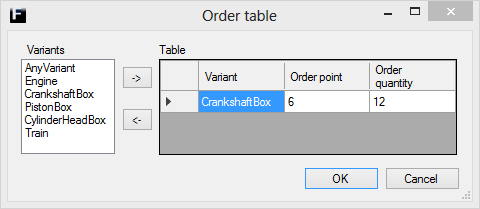
The Facade object is designed to model material handling for assembly lines. The Facade is similar to a Store but inventory is managed by ordering of different parts. The orders are specified in the setting Order table managed by the mandatory connected Order-logic. Since the inventory is managed by orders only parts that have this facade as destination are allowed to enter, for more information about the destination concept view the Order-logic.
Note: Disassemblies have a special behavior for assembled parts with destinations when any of its successors matches at least one of the destinations on the assembled parts. Destinations are handled by the Order logic, go here for more details.

Example
The example to the right illustrates what a simple engine assembly with material handling could look like. In the example a number of crankshafts, pistons, and cylinder heads need to be put on an engine. Boxes of crankshafts, pistons and cylinder heads are kept in Facades next to each assembly station and refill of these boxes in the Facades are handle by a couple of trains. The facades orders boxes through the Order logic and that governs what is being loaded on the trains.
Settings
The settings of the Facade are listed below along with a short description and possibly a link to a more detailed description about the setting.
|
Setting |
Description |
|
Name |
Sets the name of the object. |
|
Location |
Displays the location of the object. |
|
Order table |

Used to specify which variants/parts that should be kept in this Facade. In addition it also contains information (per variant) about at what inventory level a new order should be created and the quantity of such an order. In the example to the right the Facade will have an inventory of boxes containing crankshafts. Once the inventory of CrankshaftBoxes reaches 6 an order for 12 CrankshaftBoxes will be created.
|
|
Process time |
The process time of the Facade can be seen as a transportation time, a minimum time that all variants/parts entering the Facade must stay in the Facade before they move on. See process time for more details. |
|
Disturbance |
A detailed description about disturbances can be found here.
|
|
Exit Strategy |
The exit strategy sets how variants/products should exit from the object to its successors. See exit strategy for more details. |
|
Dispatch |
The dispatch setting sets how variants/products waiting to enter the object should be prioritized. See dispatch for more details. |
|
Timetable |
If the object follows a certain Timetable it will be shown here. The input-field has a drop-down containing all timetables in the model as well as an option none. Using this drop-down it is possible to select a different timetable or remove the timetable from the object by selecting none. |
|
User attributes |
Lists all attributes that the user has added to the object. See User attributes for more details. |